
Chapter 3
Table 3.2. Runways.
Class A
Class B
Runway
Runway
Item
Item
No.
Description
Requirement
Remarks
runway.
Selected transverse grade is to remain constant
for length and width of runway, except at or
adjacent to runway intersections where
pavement surfaces must be warped to match
abutting pavements.
2% min
Paved Portion of Shoulder.
10
Transverse
3% max
grade of paved
Slope downward from runway pavement.
shoulder
Unpaved Portion of Shoulder.
(a) 40 mm [1-1/2"] drop off
11
Transverse
at edge of paved shoulder
grade of
Slope downward from shoulder pavement.
(b) 5% slope first 3 m [10 ft]
unpaved
For additional information, see Figure 3.1.
from paved shoulder and
shoulder
edge of runway without
paved shoulder
(c) beyond 3 m [10 ft] from
paved shoulder and edge of
runway without paved
shoulder - 2% min, 4% max.
152.40 m
152.40 m
Army airfields.
12
Runway
[500 ft]
[500 ft]
lateral
clearance zone
152.40 m
304.80 m
Air Force, Navy, and Marine Corps.
[500 ft]
[1,000 ft]
The runway lateral clearance zone's lateral
limits coincide with the limits of the primary
surface. The ends of the lateral clearance zone
coincide with the runway ends. The ground
surface within this area must be clear of fixed
or mobile objects, and graded to the
requirements of Table 3.2, items 13 and 14.
The zone width is measured perpendicularly
from the centerline of the runway and begins at
the runway centerline.
(1) Fixed obstacles include manmade or
natural features such as buildings, trees, rocks,
terrain irregularities and any other features
constituting possible hazards to moving
aircraft. Navigational aids and meteorological
3-5


 Previous Page
Previous Page
